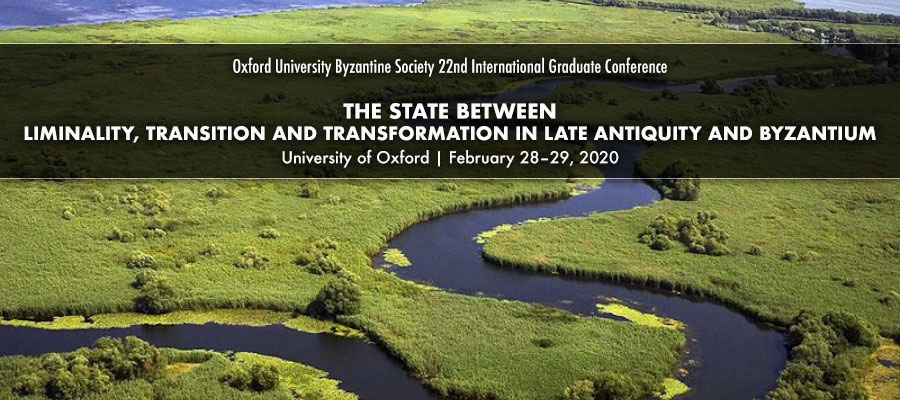The State Between: Liminality, Transition and Transformation in Late Antiquity and Byzantium, Oxford University Byzantine Society 22nd International Graduate Conference, University of Oxford, February 28–29, 2020
For many centuries, Byzantium was characterised in historiographical narratives as a transitional state: a retrospective bridge between antiquity and modernity. However, while Byzantium undoubtedly acted as an intermediary between these worlds and eras, it is important to recognise the creativity, originality, and vitality which characterised this empire and its population. Much as Late Antiquity has been reframed recently as a period of evolution rather than decline, so too can the Byzantine world be viewed in a new light through the lens of liminality. This conference aims to explore the fluid and the unfixed, periods of transition and ambiguity; the state of being ‘betwixt and between’.
There are many cases in which liminality can be applied effectively as a historiographical tool to understand aspects of the Late Antique and Byzantine world. For instance, the lives of individuals were shaped by liminal experiences, in both secular and religious spheres. From the experience of widowhood to that of a novice entering monastic life, Byzantine lives were marked by the transition from one social status and identity to another: the middle phase in which liminal personae are simultaneously ‘no longer’ and ‘not yet’, existing between positions assigned and arrayed by law, custom, convention and ceremonial. Liminal spaces permeated societies in the broader Byzantine world, from local landscapes, to religious buildings, to household interiors. As such, liminality provides a constructive framework with which to approach the transition and transformation of the Late Roman city to Medieval Islamic urbanism. On a larger scale, polities formerly on the periphery of the Byzantine world (the peoples of the Arabian Peninsula, the Steppe, the Slavic oecumene) often came suddenly to the foreground of the political landscape, resulting in the formation of new cultural networks and the shaping of identities.
Liminality is often defined in spatial terms, but it is also about process. For the cultural anthropologist Victor Turner, a ‘liminal phase’ can be an event or process which involves the disruption of existing hierarchies and power-structures. This definition of liminality as an inter-structural phase not only applies to political and economic change, but also may be extended to the subjunctive world of ideas and philosophical thought: the realm of what is possible and what may be.
Including contributions on political, social, literary, architectural and artistic history, and covering geographical areas throughout the central and eastern Mediterranean and beyond, this conference aims to provide an interdisciplinary and kaleidoscopic view of the Late Antique and Byzantine world. To that end, we encourage submissions from all graduate students and young researchers, encompassing, but not limited to, the following themes:
- Borders, Frontiers and Thresholds: cross-cultural engagement and identity formation; negotiation, hybridity and transition.
- States of Religious Identity and Practice: rituals, conversions, missionaries and pilgrimage.
- Political and Administrative Transformation: transition, social change and conflict.
- Gender and Sexuality: social norms, boundaries and transgression.
- Life on the Margins: mercenaries, merchants, outlaws and slaves.
- Liminal, Temporary and Transitional Identities: saints, soldiers, scholars and students.
- Liminal Spaces and Places: staging posts and sites of passage, the natural and the preternatural, the world of the living and of the dead.
- Conformity and Dissent: the space between dominant and minority discourses.
- Literary Works, Narratology and Liminality: histories, chronicles, hagiographies and martyrologies.
- Manuscripts: scribal habits, palimpsests, marginal comments, illustrations and other decorative elements.
- Architecture and Urbanism: liminal landscapes, changing land use, spolia and reappropriation.
- Epigraphy: textual content, form and style, interrelations between text and object.
- Numismatics and Sigillography: exchanges across boundaries, prosopography and social networks.
- Art, Material and Visual Culture: sensory perception and interactions with art objects, icons, mosaics, statues, altar screens and textiles.
- Religious Objects: relics, liturgical equipment and vestments.
- Legal Texts: overlapping legal cultures, boundaries and legal status, legislation related to the life course.
- Comparative approaches to liminality, in opposition or concordance with Late Antiquity and Byzantium.
